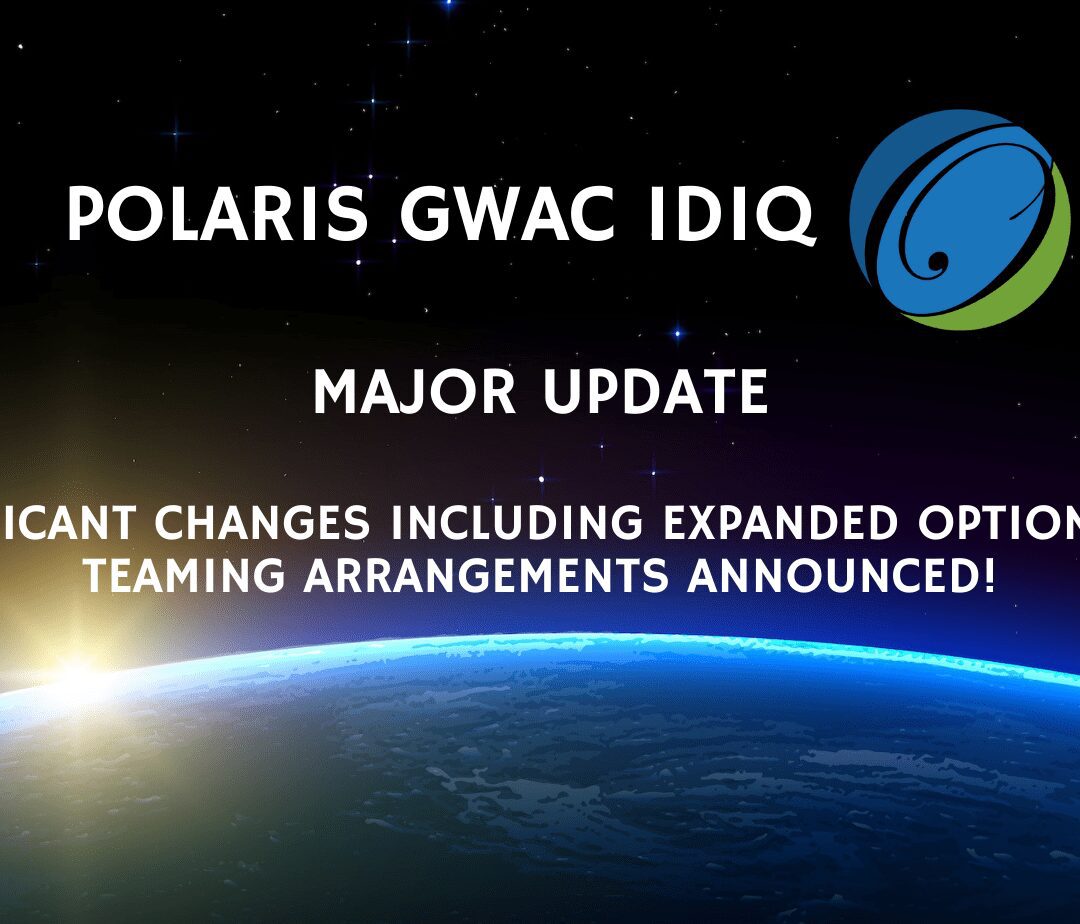The General Services Administration (GSA) made significant changes to the Polaris Governmentwide Acquisition Contract (GWAC) draft solicitation and scorecard, including expanding options for teaming arrangements.
GSA this week issued answers to industry questions to help finalize and clarify language in the draft Request for Proposal (RFP). The Agency will first open the competition to the Small Business Pool and Women-Owned Small Business Pool, and final RFPs for those competitions are expected soon.
Under the latest revisions, GSA expanded the definition of “business arrangement” to include joint ventures (including a Mentor-Protégé Joint Venture) and its proposed subcontractor(s). The Agency also revised its Organizational Risk Assessment to expand the conditions for when a “business arrangement that is considered to have previously performed in the same business arrangement.”
GSA also reduced the points awarded in the Organizational Risk Assessment categories to entities that have acted in the same business relationship before, which significantly increases the amount of organizations who can participate in this competition. Prior to this update, a subcontractor who had not previously worked as a subcontractor to the prime would have to be able to increase the score by more than 8,500 points in order for their presence to be a net gain. Now the points awarded in this area is 5,000 making it a much lower barrier to achieve when bringing on new subcontractors.
OST asked GSA to reduce the points awarded in the Organizational Risk Assessment section to enable greater participation from small business subcontractors who have a lot to offer GSA but could not overcome the 8,500-point barrier. We are very excited that GSA accepted the rationale we provided, and we hope this makes it much easier for many small business to find teaming partners for Polaris.
For the latest updates on the Polaris contract, see our Polaris contract page. The full questions and answers from GSA can be found at the GSA Interact Site.
Polaris replaces GSA’s $15 billion Alliant 2 Small Business contract. GSA anticipates releasing the RFPs for the Historically Underutilized Business Zones (HUBZone) and Service-Disabled Veteran-Owned Small Businesses (SDVOSB) Pools in the 4th quarter of FY2022.
Proposals will be due approximately 30 days after the solicitation is posted, according to GSA. That leaves little time for bidders to shore up their teaming agreements and make sure they’re maximizing their score while remaining complaint with the RFP.
OST Global Solutions is here to help maximize your score on your Polaris bid. We will help you develop a draft scorecard, perform a gap analysis to ensure that you make the cut-off score, and find ways to help you out-distance your competition. No matter how much assistance you require, we’re here to help.
Reach out to us to discuss how we can help you develop a winning proposal.
service@ostglobalsolutions.com
Video Transcript
GSA has come out with another update on the long-awaited Polaris opportunity, and this time they’re saying that the small business and woman owned small business pool is going to be released soon. Whatever that means. They’ve been saying that for three months. Hopefully, we’re going to see something come out here in the next couple of weeks or so.
They’re delaying the HUBZone and Service-Disabled Veteran owned small business pools until Q4 2022, so we still have a few months left for that. Some minor changes but really informative and some major changes, too. I’m not going to go over all the minor changes, but you can check that out. We’ve included a link to a newsletter down below to where you can see the updates and a link to the GSA website. The major change is something that we advocated for back in November.
We asked a question to GSA about their intent for the organizational risk assessment. Before, it was 8,500 points that you would get if you were either bidding by yourself, or you’re bidding on the same form or organization that you have executed on a contract previously. What that means is that if you’re bidding as the prime and you’re using a subcontractor that has worked with you before as a subcontractor, then you would get 8,500 points. However, what this really did was effectively eliminate teaming for anybody that you haven’t worked with before in that same business relationship. So that included JV’s and included any of the subcontractors that you could bring on to boost your score potentially, because you wouldn’t get that at 8,500 points in the organizational risk assessment category. A subcontractor would essentially have to bring two large contracts, and then some other stuff too because that was only 6,000 points.
They would have to bring another customer or maybe a cybersecurity contract. It was a pretty high barrier. From a lot of the evaluations that we’ve done, here at OST, if you were able to bring another 8500 points to a bid to overcome that organizational risk assessment, then you were probably going to prime this anyway. We asked this question, and GSA lowered that to 5,000 points, which was a huge change.
Now, it’s much easier to bring subcontractors on and overcome that deficit, even if you have never worked together. We’re really excited about this going to open up the door for a lot of smaller companies that maybe can’t prime themselves to get on a team now because maybe they could bring more than that 5,000 points to a bid. Very exciting and it’s going to open up a lot of new businesses to be able to participate on this opportunity.
We at OST have done a lot of independent evaluations of people score, and we’ve helped form teams, and we are experts in putting these types of proposals together. So, reach out to us if you’re interested in one of those three things, independent score assessment, getting on a team or forming your own team, and then of course putting your proposal together.
Upcoming Bid & Proposal Academy Classes
Winning Government Cost Proposals Including AI Essentials (Live Class)
OST Global Solutions Virtual Classroom MD, United StatesDeveloping a Winning Cost Volume course helps you increase your federal contract win probability. We focus on Government contract evaluation, pricing fundamentals such as cost buildup and cost volume elements, price strategy, developing basis of estimate (BOE), coming up with assumptions, Work Breakdown Structure (WBS), cost volume narrative, winning in lowest price technically acceptable proposals (LPTA), and much more.
Master AI to Enhance BD, Capture, & Proposal Processes – Updated to Include the Latest AI Developments (Live Class)
OST Global Solutions Virtual Classroom MD, United StatesAre you ready to enhance your bid flow, improve your Pwin, cut down the time it takes to do most BD tasks, improve decision-making, and reduce proposal risk by ensuring your submissions are compliant and compelling? This course is specially designed for BD professionals in Government contracting firms seeking to harness the power of AI in their operations. Over three comprehensive sessions, you will gain the knowledge and tools to transform your BD strategies and execution. Learn More
Proposal Graphics Conceptualization & Design (Live Class)
OST Global Solutions Virtual Classroom MD, United StatesThis course provides the skills necessary to conceptualize proposal graphics that convey your winning solution to Government customers. In addition to brainstorming on a graphic idea, this training shows you how to design an action caption, sketch a graphic concept, deliver a specific visual message to the Government customer, and use professional graphic design principles and resources to make your graphics look attractive.




